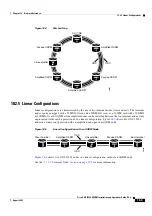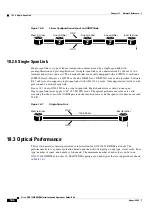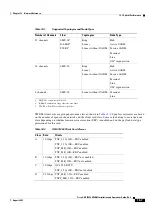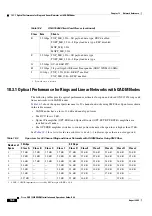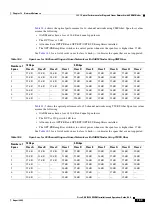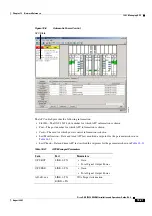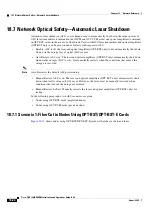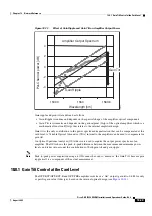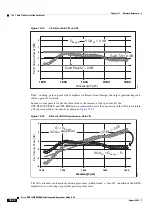
18-19
Cisco ONS 15454 DWDM Installation and Operations Guide, R6.0
August 2005
Chapter 18 Network Reference
18.4.2 APC at the Node and Network Levels
changed by the amplifier. Amplifier gain is recalculated every time the number of provisioned channels
returns to zero. If you need to force a recalculation of the gain, move the number of channels back to
zero.
18.4.2 APC at the Node and Network Levels
The amplifier adjusts the gain to compensate for span loss. Span loss changes due to aging fiber and
components, or changes in operating conditions. To correct the gain or express variable optical
attenuator (VOA) setpoints, APC calculates the difference between the power value read by the
photodiodes and the expected power value. The expected power values is calculated using:
•
Provisioned per-channel power value
•
Channel distribution (the number of express, add, and drop channels in the node)
•
ASE estimation
Channel distribution is determined by the sum of the provisioned and failed channels. Information about
provisioned wavelengths is sent to APC on the applicable nodes during circuit creation. Information
about failed channels is collected through a signaling protocol that monitors alarms on ports in the
applicable nodes and distributes that information to all the other nodes in the network.
ASE calculations purify the noise from the power level reported from the photodiode. Each amplifier can
compensate for its own noise, but cascaded amplifiers cannot compensate for ASE generated by
preceding nodes. The ASE effect increases when the number of channels decreases; therefore, a
correction factor must be calculated in each amplifier of the ring to compensate for ASE build-up.
APC is a network-level feature. The APC algorithm designates a master node that is responsible for
starting APC hourly or every time a new circuit is provisioned or removed. Every time the master node
signals for APC to start, gain and VOA setpoints are evaluated on all nodes in the network. If corrections
are needed in different nodes, they are always performed sequentially following the optical paths starting
from the master node.
APC corrects the power level only if the variation exceeds the hysteresis thresholds of +/– 0.5 dB. Any
power level fluctuation within the threshold range is skipped since it is considered negligible. Because
APC is designed to follow slow time events, it skips corrections greater than 3 dB. This is the typical
total aging margin that is provisioned during the network design phase. After you provision the first
channel or the amplifiers are turned up for the first time, APC does not apply the 3 dB rule. In this case,
APC corrects all the power differences to turn up the node.
Note
Software R6.0 does not report corrections that are not performed and exceed the 3 dB correction factor
to Cisco Transport Controller (CTC), Cisco Transport Manager (CTM), and Transaction Language One
(TL1) management interfaces.
To avoid large power fluctuations, APC adjusts power levels incrementally. The maximum power
correction is +/– 0.5 dB. This is applied to each iteration until the optimal power level is reached. For
example, a gain deviation of 2 dB is corrected in four steps. Each of the four steps requires a complete
APC check on every node in the network. APC can correct up to a maximum of 3 dB on an hourly basis.
If degradation occurs over a longer time period, APC will compensate for it by using all margins that
you provision during installation.
When no margin is available, adjustments cannot be made because setpoints exceed ranges. APC
communicates the event to CTC, CTM, and TL1 through an APC Fail condition. APC will clear the APC
fail condition when the setpoints return to the allowed ranges.
APC automatically disables itself when:
Summary of Contents for ONS 15454 DWDM
Page 38: ...Figures xxxviii Cisco ONS 15454 DWDM Installation and Operations Guide R6 0 August 2005 ...
Page 54: ...Procedures liv Cisco ONS 15454 DWDM Installation and Operations Guide R6 0 August 2005 ...
Page 64: ... 64 Cisco ONS 15454 DWDM Installation and Operations Guide R6 0 August 2005 Chapter ...

